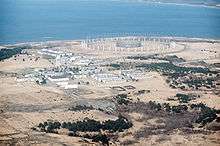AN/FLR-9
The AN/FLR-9 is a type of very large circular "Wullenweber" antenna array, built at eight locations during the cold war for HF/DF direction finding of high priority targets. The worldwide network, known collectively as "Iron Horse", could locate HF communications almost anywhere on Earth. Because of the exceptionally large size of its outer reflecting screen (1056 vertical steel wires supported by 96 120-foot towers), the FLR-9 was commonly referred to by the nickname "Elephant Cage." Constructed in the early to mid 1960s, in May 2016 the last operational FLR-9 at Joint Base Elmendorf-Richardson in Alaska was decommissioned.[1] It can be confused with the US Navy's AN/FRD-10, which also used a Wullenweber antenna.
Description
The AN/FLR-9 Operation and Service Manual[2] describes the array as follows:
The antenna array is composed of three concentric rings of antenna elements. Each ring of elements receives RF signals for an assigned portion of the 1.5 to 30-MHz radio spectrum. The outer ring normally covers the 2 to 6-MHz range (band A), but also provides reduced coverage down to 1.5 MHz. The center ring covers the 6 to 18-MHz range (band B) and the inner ring covers the 18 to 30-MHz range (band C). Band A contains 48 sleeve monopole elements spaced 78.4 feet apart (7.5 degrees). Band B contains 96 sleeve monopole elements spaced 37.5 feet (11.43 m) apart (3.75 degrees). Band C contains 48 antenna elements mounted on wooden structures placed in a circle around the central building. Bands A and B elements are vertically polarized. Band C elements consist of two horizontally polarized dipole antenna subelements electrically tied together, and positioned one above the other.
The array is centered on a ground screen 1,443 feet (439.8 m) in diameter. The arrangement permits accurate direction finding of signals from up to 4000 nautical miles (7408 km) away.

FLR-9s were constructed at the following places:[3]
- USASA Field Station Augsburg (Gablingen Kaserne), Germany
- Chicksands, England
- Clark AB, Philippines
- Joint Base Elmendorf-Richardson, Alaska, USA (formerly designated as Elmendorf AFB)
- Karamursel, Turkey
- 7th Radio Research Field Station/Ramasun Station, Udon Thani Province, Thailand
- Misawa AB, Japan, built 1963 to 1965, demolished beginning in 2014.[4]
- San Vito dei Normanni Air Station, Italy (near Brindisi, Italy)
Advances in technology have made the FLR-9 obsolete. In 1997, the FLR-9 at the former Clark AB in the Philippines was converted into a 35,000-seat fabric-covered amphitheatre. In early May 2002, systematic dismantling of the FLR-9 at San Vito began, and it was totally deconstructed by the end of that month. Although the markings of where the array stood remain in the ground, the structure is completely gone.[5]
Demolition of the FLR-9 at Misawa began in October 2014.[6]
A decommissioning ceremony for the last active FLR-9, at Joint Base Elmendorf-Richardson, was held on May 25, 2016. [1]
References
- Bowman, Bonney (25 May 2016). "A look inside a classified Cold War-era antenna site, now shut down". KTVA. Archived from the original on 1 May 2017.
- AN/FLR-9 Operation and Service manual
- Budiansky, Stephen (2016). Code Warriors. New York: Alfred A. Knopf. p. 161. ISBN 9780385352666.
- Slavin, Erik (15 October 2014). "Misawa begins dismantling its 'Elephant Cage'". Stars and Stripes.
- http://virtualglobetrotting.com/map/former-an-flr-9-site-hfdf-in-italy/view/?service=0
- Kyodo News, "'Elephant Cage' antennas to be axed", The Japan Times, 8 October 2012, p. 2
External links
- AN/FLR-9 Operation and Service manual
- USASA Field Station Augsburg – history of the Augsburg site
- Extreme close-up hi-res aerial photo of FLR-9 at Chicksands just before being dismantled in 1996
- FLR-9 at Ramasun Station, Udon Thani, Thailand 17.2917333°N 102.868850°E
- FLR-9 at Elmendorf AFB, Alaska 61.264486°N 149.851198°W
- FLR-9 at Gablingen, Augsburg, Germany 48.449278°N 10.863161°E
- FLR-9 at Misawa, Honshū Island, Japan 40.720053°N 141.326580°E
- FLR-9 site at Chicksands, Bedfordshire, UK 52.042580°N 0.388298°W
- FLR-9 site at Clark AFB, Philippines 15.204687°N 120.528173°E
- FLR-9 site at Karamursel AS, Turkey 40.709453°N 29.528074°E
- FLR-9 site at San Vito dei Normanni AS, Italy 40.645638°N 17.841368°E
- AN/FLR-9 information on FAS.org
- FLR-9 photo collection on FTVA.org